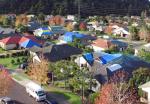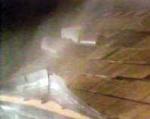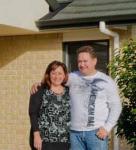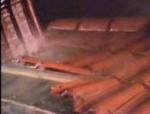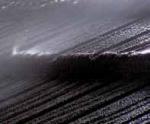The Tornado-Proof Roof
On Tuesday 3rd May 2011, the Auckland suburb of Albany experienced ‘an extreme weather event’. A large tornado touched down at 3.15pm and slammed through a shopping mall before moving south leaving a 5km trail of destruction.
Weather Watch chief analyst Philip Duncan said that the speed of the winds in the tornado would have been between 160kmh and 200 kmh. The tornado claimed one life and seriously damaged close to 30 homes.
One of the houses directly in the tornado’s path was a 12-year-old home belonging to Sharon and Mike Tomoana. Sharon recounts the experience:
“Mike was at home and watched the twister coming towards our house. He said the noise was like the engine of a Jumbo jet – and he should know, he’s an Air New Zealand pilot. As it got closer, he could see sheets of iron and concrete roof tiles whirling around. When he realised that it was headed directly for our house, he ran into the kitchen, lay down on the tiles and covered his head.”
Concrete tiles became missiles
An aerial view of the Tomoana’s neighbourhood reveals that several homes suffered extensive roof damage. However the Tomoana’s roof – clad in Gerard Corona Shake pressed-steel tiles - remained intact.
“Our roof was the only one that stayed down and intact. The only damage we suffered was a slice to one metal tile, caused by a flying concrete tile from the neighbour’s roof. All of the homes around us have concrete tile roofs and in strong winds, the front of the tile lifts and the tile flies off, becoming
a lethal missile. They weigh about 3kg each.”
Roof failures resulted in extensive water damage
Strong winds were only part of the problem that day. Three hours of torrential rain followed the tornado, drenching the ceiling cavities of homes that had lost their concrete tile roofs.
“Our elderly neighbours lost their concrete tile roof and the rain poured in, soaking their ceiling insulation. The ceiling sagged and you could poke your finger through the gib board. These people are in their 70s and they had to cope with wet ceiling, wet bedrooms and wet carpet, and of course their electricity had to be turned off, because of the risk of electrocution.”
Gerard support arrives without delay
Although the Tomoana’s roof suffered nothing more than a slice to one tile, Gerard were at the house before Sharon even thought about calling them.
“We were quite gobsmacked. Mike had just come off the roof and Richard Field, the Gerard Roofs guy, pulls up in the driveway. He said ‘I put your roof on 12 years ago and just want to check that you’re OK’. Mike told him about the little bit of damage and Richard said he’d be back after lunch with the right size
piece. Not only did he arrive back with the new tile, he helped Mike to install it so that we wouldn’t get any water in the ceiling cavity.”
Gerard gets the nod for beach house
Sharon and Mike hadn’t given their roof much thought before the tornado struck, although Sharon’s brother – a builder – had said to them that they had a ‘hurricaneproof roof’ when they bought the home 12 years ago.
“Mike and I are very grateful to have a Gerard Roof. We bought this house brand new from the builder, and at the time we simply thought it was a good-looking roof. We didn’t realise the durability and quality of our roof until Tuesday’s tornado. We have land in Rarotonga and will be building a beach house on it soon. It will definitely have a Gerard roof. I’ve seen a couple of storms in Raro – having a hurricane-proof roof will be really important there.”
We have more tornados than you might think
Generally we think of tornadoes in the notorious “Tornado alley” in the midwest of the United States but statistics show us that Auckland alone has experienced tornadoes in August 1980, May 1982, September 1986, May 1991, August 1992; March 1997.
The worst recorded tornado hit Franklin in the Waikato in 1948 leaving 3 dead and destroyed nearly 200 shops and houses. May 1991 Albany experienced a tornado which lifted roofs and flying debris claimed the life of a bulldozer driver.
New Plymouth has recently experience a tornado which caused Hundreds of thousands of dollars damage. As recently as 10th July 2011 a tornado struck Waikanae destroying buildings as it travelled across farmland uprooting trees and reportedly lifted a 40,000 litre water tank.
The “wind uplift” performance of roofing products is becoming an increasingly important factor in New Zealand as more people build on sites that take full advantage of our undulating topography and coastal environment.
Gerard roofs interlocking tiles are secured in place with a unique horizontal fastening system. The result is a very strong roof with superior wind resistance, which allows specification in extremely high wind zones.
When roofs are lost due to high winds it is not accurate to say the roof is blown off... in reality it is a combination of the imbalance of high pressure created by the wind moving over the roof and the low pressure in the roof cavity. This creates uplift that has been compared to the same principle which creates high and low pressure on an aircraft wing giving the plane lift.

